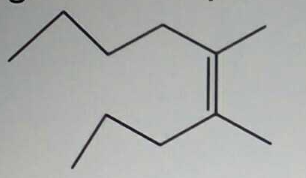Match each alkene with the appropriate heat of combustion:
Heats of combustion (kJ/mol) :5293,4658,4650,4638,4632
2,4−Dimethyl-2-pentene , 4,4−Dimethyl-2-pentene , 2,4,4−Trimethyl-2-pentene, 2,4-Dimethyl-1-pentene, 1-Heptene
The correct Answer is:4656
To solve the problem of matching each alkene with its appropriate heat of combustion, we will follow these steps:
Step 1: Understand the Relationship Between Stability and Heat of Combustion
- The stability of alkenes is inversely proportional to their heat of combustion. This means that the more stable the alkene, the lower its heat of combustion will be. Conversely, the less stable the alkene, the higher its heat of combustion.
Step 2: Determine the Number of Alpha Hydrogens for Each Alkene
- The stability of an alkene is directly related to the number of alpha hydrogens it has. More alpha hydrogens indicate more hyperconjugation and thus greater stability.
1. 2,4-Dimethyl-2-pentene:
- Structure: (CH3)2C=CH(CH3)CH2
- Alpha Hydrogens: 7
2. 4,4-Dimethyl-2-pentene:
- Structure: (CH3)2C=CH(CH3)C(CH3)2
- Alpha Hydrogens: 6
3. 2,4,4-Trimethyl-2-pentene:
- Structure: (CH3)2C=CH(CH3)C(CH3)2
- Alpha Hydrogens: 6
4. 2,4-Dimethyl-1-pentene:
- Structure: CH2=CH(CH3)C(CH3)2
- Alpha Hydrogens: 5
5. 1-Heptene:
- Structure: CH2=CH(CH2)5CH3
- Alpha Hydrogens: 2
Step 3: Order the Alkenes by Stability
- Based on the number of alpha hydrogens, we can rank the alkenes from most stable to least stable:
- 2,4-Dimethyl-2-pentene (7 alpha hydrogens) - Most stable
- 4,4-Dimethyl-2-pentene (6 alpha hydrogens)
- 2,4,4-Trimethyl-2-pentene (6 alpha hydrogens)
- 2,4-Dimethyl-1-pentene (5 alpha hydrogens)
- 1-Heptene (2 alpha hydrogens) - Least stable
Step 4: Match the Alkenes with Their Heats of Combustion
- The heat of combustion values given are: 5293, 4658, 4650, 4638, 4632 kJ/mol.
- Since the least stable alkene has the highest heat of combustion, we can match them as follows:
- 1-Heptene (least stable) → 5293 kJ/mol
- 2,4-Dimethyl-1-pentene → 4658 kJ/mol
- 4,4-Dimethyl-2-pentene → 4650 kJ/mol
- 2,4,4-Trimethyl-2-pentene → 4638 kJ/mol
- 2,4-Dimethyl-2-pentene (most stable) → 4632 kJ/mol
Final Matches
- 1-Heptene: 5293 kJ/mol
- 2,4-Dimethyl-1-pentene: 4658 kJ/mol
- 4,4-Dimethyl-2-pentene: 4650 kJ/mol
- 2,4,4-Trimethyl-2-pentene: 4638 kJ/mol
- 2,4-Dimethyl-2-pentene: 4632 kJ/mol
- The stability of alkenes is inversely proportional to their heat of combustion. This means that the more stable the alkene, the lower its heat of combustion will be. Conversely, the less stable the alkene, the higher its heat of combustion.
- The stability of an alkene is directly related to the number of alpha hydrogens it has. More alpha hydrogens indicate more hyperconjugation and thus greater stability.
- Structure: (CH3)2C=CH(CH3)CH2
- Alpha Hydrogens: 7
- Structure: (CH3)2C=CH(CH3)C(CH3)2
- Alpha Hydrogens: 6
- Structure: (CH3)2C=CH(CH3)C(CH3)2
- Alpha Hydrogens: 6
- Structure: CH2=CH(CH3)C(CH3)2
- Alpha Hydrogens: 5
- Structure: CH2=CH(CH2)5CH3
- Alpha Hydrogens: 2
- Based on the number of alpha hydrogens, we can rank the alkenes from most stable to least stable:
- 2,4-Dimethyl-2-pentene (7 alpha hydrogens) - Most stable
- 4,4-Dimethyl-2-pentene (6 alpha hydrogens)
- 2,4,4-Trimethyl-2-pentene (6 alpha hydrogens)
- 2,4-Dimethyl-1-pentene (5 alpha hydrogens)
- 1-Heptene (2 alpha hydrogens) - Least stable
- The heat of combustion values given are: 5293, 4658, 4650, 4638, 4632 kJ/mol.
- Since the least stable alkene has the highest heat of combustion, we can match them as follows:
- 1-Heptene (least stable) → 5293 kJ/mol
- 2,4-Dimethyl-1-pentene → 4658 kJ/mol
- 4,4-Dimethyl-2-pentene → 4650 kJ/mol
- 2,4,4-Trimethyl-2-pentene → 4638 kJ/mol
- 2,4-Dimethyl-2-pentene (most stable) → 4632 kJ/mol
- 1-Heptene: 5293 kJ/mol
- 2,4-Dimethyl-1-pentene: 4658 kJ/mol
- 4,4-Dimethyl-2-pentene: 4650 kJ/mol
- 2,4,4-Trimethyl-2-pentene: 4638 kJ/mol
- 2,4-Dimethyl-2-pentene: 4632 kJ/mol
Topper's Solved these Questions
- GOCBOOK - MOTIONCHAPTER - GOCEXERCISE - Exercise - 3
44 Videos
- GOCBOOK - MOTIONCHAPTER - GOCEXERCISE - Exercise - 4 Level - I
13 Videos
- GOCBOOK - MOTIONCHAPTER - GOCEXERCISE - Exercise - 2 (Level - I)
31 Videos
- GASEOUS STATE BOOK - MOTIONCHAPTER - GASEOUS STATE EXERCISE - EXERCISE-4( LEVEL-II)
19 Videos
- GRIGNARD REAGENTBOOK - MOTIONCHAPTER - GRIGNARD REAGENTEXERCISE - EXERCISE-2
16 Videos
Similar Questions
Knowledge Check
2, 4-Dimethyl pentan -3-ol is a
Aprimary alcoholBsecondary alcoholCtertiary alcoholDdihydric alcoholThe structure of 4-methyl-2-penten-1-ol is
A(CH3)2CHCH2=CHCH2OHBCH3CHOH−CH−C(CH3)2C(CH3)2C=CHCH2CH2OHDCH3CH2CH=CHCH2OH
4-methyl-2-pentene
View Solution4-methyl-3-penten-2-one
View Solution3,3-dimethyl-1-penten-4-yne
View SolutionThe IUPAC name of the given compound is

a. 4,5-Dimethyl-1-non-ene
b. 4,5-Dimethyl-non-4-ene
c. 3,4-Dimethyl-5-non-ene
d. 2,3-Dipropyl-2-butene
View SolutionCosider the two alkenes 2-methhyl-1-pentene and 2-methyl-2-pentene and decide which would be most stable.
View SolutionCosider the two alkenes 2-methhyl-1-pentene and 2-methyl-2-pentene and decide which would be most stable.
View Solution
